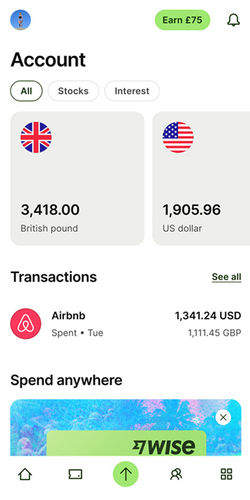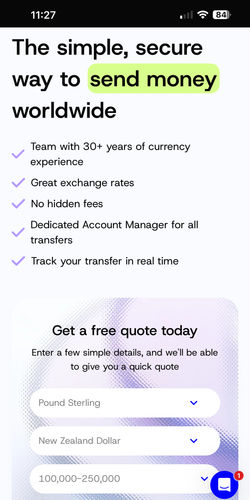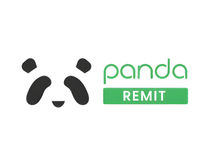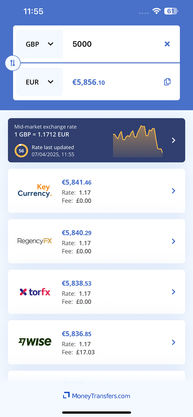Find the best ways to transfer money to Canada
Compare money transfer deals for sending CAD.
Find the best, cheapest, and easiest ways to send money to Canada at the best CAD exchange rates.
Read on for the best deals, expert information, and all you need to transfer money to Canada.
Send money to Canada
"Over 16 million customers use Wise, mostly for their excellent mobile app, transparent fee structure & use of mid-market rates. Now increasingly used for larger transfers."
"Over 16 million customers use Wise, mostly for their excellent mobile app, transparent fee structure & use of mid-market rates. Now increasingly used for larger transfers."
"Over 16 million customers use Wise, mostly for their excellent mobile app, transparent fee structure & use of mid-market rates. Now increasingly used for larger transfers."
"Xe has over 30 years of currency exchange experience, and is one of the most reputable names on the market. 200 countries, 100 currencies, & funds often received in seconds."
"Xe has over 30 years of currency exchange experience, and is one of the most reputable names on the market. 200 countries, 100 currencies, & funds often received in seconds."
"Xe has over 30 years of currency exchange experience, and is one of the most reputable names on the market. 200 countries, 100 currencies, & funds often received in seconds."
"Over 16 million customers use Wise, mostly for their excellent mobile app, transparent fee structure & use of mid-market rates. Now increasingly used for larger transfers."
"Over 16 million customers use Wise, mostly for their excellent mobile app, transparent fee structure & use of mid-market rates. Now increasingly used for larger transfers."
"Over 16 million customers use Wise, mostly for their excellent mobile app, transparent fee structure & use of mid-market rates. Now increasingly used for larger transfers."
"Currencies Direct have over 30 years of global money transfer expertise. Award winning service with a TrustPilot rating of 4.9. Lock-in rates for the future or trade 24/7 on web or mobile."
"Currencies Direct have over 30 years of global money transfer expertise. Award winning service with a TrustPilot rating of 4.9. Lock-in rates for the future or trade 24/7 on web or mobile."
"Currencies Direct have over 30 years of global money transfer expertise. Award winning service with a TrustPilot rating of 4.9. Lock-in rates for the future or trade 24/7 on web or mobile."
"Revolut has 50+ million customers globally. You can hold up to 36 currencies in the app and send money quickly in 70+ currencies to 160+ countries."
"Revolut has 50+ million customers globally. You can hold up to 36 currencies in the app and send money quickly in 70+ currencies to 160+ countries."
"Revolut has 50+ million customers globally. You can hold up to 36 currencies in the app and send money quickly in 70+ currencies to 160+ countries."
"24/7 live chat support provided in six languages. Special first transfer rates available, with airtime topup supported to many countries in Africa, Asia and South America."
"24/7 live chat support provided in six languages. Special first transfer rates available, with airtime topup supported to many countries in Africa, Asia and South America."
"24/7 live chat support provided in six languages. Special first transfer rates available, with airtime topup supported to many countries in Africa, Asia and South America."
"Key Currency offers a personal service with a dedicated account manager. There are no transfer limits or fees which is perfect for larger send amounts."
"Key Currency offers a personal service with a dedicated account manager. There are no transfer limits or fees which is perfect for larger send amounts."
"Key Currency offers a personal service with a dedicated account manager. There are no transfer limits or fees which is perfect for larger send amounts."
"Xe has over 30 years of currency exchange experience, and is one of the most reputable names on the market. 200 countries, 100 currencies, & funds often received in seconds."
"Xe has over 30 years of currency exchange experience, and is one of the most reputable names on the market. 200 countries, 100 currencies, & funds often received in seconds."
"Xe has over 30 years of currency exchange experience, and is one of the most reputable names on the market. 200 countries, 100 currencies, & funds often received in seconds."
"OFX have been helping individuals and businesses send money for over 25 years. Transfer in 50+ currencies to 170+ countries, with 24/7 phone access to currency experts."
"OFX have been helping individuals and businesses send money for over 25 years. Transfer in 50+ currencies to 170+ countries, with 24/7 phone access to currency experts."
"OFX have been helping individuals and businesses send money for over 25 years. Transfer in 50+ currencies to 170+ countries, with 24/7 phone access to currency experts."
"Regency's UK-based account management team has vast experience. Get support on all kinds of transfers, from overseas property transactions to business payments & more."
"Regency's UK-based account management team has vast experience. Get support on all kinds of transfers, from overseas property transactions to business payments & more."
"Regency's UK-based account management team has vast experience. Get support on all kinds of transfers, from overseas property transactions to business payments & more."
"Currencyflow is a modern FX broker backed by industry veterans with 30+ years of currency trading experience. Contact the UK-based team for a free quote."
"Currencyflow is a modern FX broker backed by industry veterans with 30+ years of currency trading experience. Contact the UK-based team for a free quote."
"Currencyflow is a modern FX broker backed by industry veterans with 30+ years of currency trading experience. Contact the UK-based team for a free quote."
"Remitly focuses on sending money to friends and family in Asia, Africa and South America. Wide coverage and well-suited to regular transfers home."
"Remitly focuses on sending money to friends and family in Asia, Africa and South America. Wide coverage and well-suited to regular transfers home."
"Remitly focuses on sending money to friends and family in Asia, Africa and South America. Wide coverage and well-suited to regular transfers home."
"Lumon has cared for over 69,000 customers since 2000. Get support for larger transfers from dedicated currency specialists."
"Lumon has cared for over 69,000 customers since 2000. Get support for larger transfers from dedicated currency specialists."
"Lumon has cared for over 69,000 customers since 2000. Get support for larger transfers from dedicated currency specialists."
"Xoom, a PayPal service, allows you to send money in more than 160 countries. You can send cash for over-the-counter pickup or home delivery, as well as send by bank transfer or debit card."
"Xoom, a PayPal service, allows you to send money in more than 160 countries. You can send cash for over-the-counter pickup or home delivery, as well as send by bank transfer or debit card."
"Xoom, a PayPal service, allows you to send money in more than 160 countries. You can send cash for over-the-counter pickup or home delivery, as well as send by bank transfer or debit card."
"Securely send money to and from 150+ countries and 20+ currencies. Same-day transfers avaialble on most major currencies."
"Securely send money to and from 150+ countries and 20+ currencies. Same-day transfers avaialble on most major currencies."
"Securely send money to and from 150+ countries and 20+ currencies. Same-day transfers avaialble on most major currencies."
"Fast, secure internatinal transfers with no fees and transparent rates. They offer a free currency card for use at home and abroad."
"Fast, secure internatinal transfers with no fees and transparent rates. They offer a free currency card for use at home and abroad."
"Fast, secure internatinal transfers with no fees and transparent rates. They offer a free currency card for use at home and abroad."
"Send money to over 40 destinations online and in the mobile app."
"Send money to over 40 destinations online and in the mobile app."
"Send money to over 40 destinations online and in the mobile app."
"Paysend has transparent fees and rates, with transfer sent within seconds to your recipient's bank. They also have global 24/7 support for any enquiries, and bank-level security."
"Paysend has transparent fees and rates, with transfer sent within seconds to your recipient's bank. They also have global 24/7 support for any enquiries, and bank-level security."
"Paysend has transparent fees and rates, with transfer sent within seconds to your recipient's bank. They also have global 24/7 support for any enquiries, and bank-level security."
"Moneycorp is an established player in the market, with a focus on private clients and corporates. Make overseas payments in over 120 currencies and 190 countries."
"Moneycorp is an established player in the market, with a focus on private clients and corporates. Make overseas payments in over 120 currencies and 190 countries."
"Moneycorp is an established player in the market, with a focus on private clients and corporates. Make overseas payments in over 120 currencies and 190 countries."
"Moneygram is a well established service with over 80 years in the sector. They support over 200 countries worldwide and have over 440,000 retail locations."
"Moneygram is a well established service with over 80 years in the sector. They support over 200 countries worldwide and have over 440,000 retail locations."
"Moneygram is a well established service with over 80 years in the sector. They support over 200 countries worldwide and have over 440,000 retail locations."
How to send money to Canada with the best rate
Always compare rates
Don't pay more than you have to. Use our live comparison tool to make sure you aren't missing the best rates when sending money to Canada.
Choose a provider
Select the provider that offers you the most CAD and fits your needs.
Click, sign up & send
Follow the steps & make your transfer. Your funds will soon be on their way to your chosen country & currency.
We found Wise to be the best way to send money to Canada.
After testing and reviewing 18 money transfer providers servicing Canada, Wise came out on top.
Wise offers quick transfers, adds a 0.02% markup on CAD transfers, and costs $26.9 in fees.
This makes it the best option for a mix of cost, speed & features for CAD transfers.

Cheapest way to send money to Canada: Key Currency
If you want to make the most of your CAD transfer, the cheapest way is to use Key Currency and pay for your transfer with a bank transfer.
With just $0 in fees and 0.25% markup, Key Currency is 0.01% cheaper than the next best option.
With Wise, if you were to send 7,000 USD to CAD, your recipient would get 9,549.3 Canadian Dollars, this is more than with other providers on our list.
*Based on 7,000 USD transfer.

Currencyflow: The fastest way to send money to Canada
With Currencyflow, the transfer time to Canada is minutes - 24 hours.
They charge $0 in fees and apply a 0.26% markup on the CAD exchange rate, which is 0% better than the second-best option.
For the best combination of cost and speed, we suggest using bank transfer to fund your CAD transfer.

The easiest way to send money to Canada: Wise
They offer transparent fees, charging $26.9 per transfer with 0.02% markup added to the CAD rate.
Getting started with Wise takes less than 3 minutes, making it a fast, affordable, and user-friendly choice for sending Canadian Dollars.

Consider this before sending money to Canada
Canada is one of the most popular destinations for international money transfers, whether you're sending funds to family, paying school fees, or investing from abroad.
With 18 companies offering services to Canada, it’s important to compare options carefully.
Fees, delivery time, and exchange rates can vary significantly depending on how and where you send your money.
Based on 7 days user data:
Key Currency offered the cheapest transfers to Canada in 100% of searches
Currencyflow was the fastest, appearing in 1 searches
The average USD to CAD mid-market rate was 1.3752
Sending large amounts of CAD to Canada
Wise consistently ranked as the top choice for large CAD transfers. They charge $26.9 per transfer to Canada and apply only a 0.02% markup on the CAD exchange rate.
Whether you’re purchasing property, paying tuition fees in CAD, planning a wedding in Canada, or making business payments, Wise ensures a smooth and secure process.
When sending large amounts of Canadian Dollar to Canada, consider factors like transfer limits, markup on the CAD rate, customer service, and any legal, tax, or government-imposed restrictions in Canada.

The costs of sending money to Canada
The cost of CAD transfers depends on where your location, amount, funding and withdrawal methods, transfer fees, and the markup added on top of the CAD exchange rate.
Exchange rate markup
The exchange rate markup is the percentage added to the mid-market rate (the "real" CAD rate) by the service provider.
For example, Wise offers one of the best exchange rates by applying a 0.02% markup on the USD-CAD exchange rate.
This means you receive 1.3752 CAD - 0.02% for every US Dollar sent.
Transfer fees
Transfer fees to Canada can be either fixed, percentage-based, or a combination of both.
Suppose you want to send $7,000 to Canada (CAD).
After analyzing 18 services supporting CAD, Key Currency appears to have the lowest fee of $0 per transfer to Canada.
Deposit method
The way you fund your CAD transfers can significantly affect the cost.
bank transfer is the overall cheapest deposit method for sending money to Canada.

Getting the best CAD rate when sending money to Canadian Dollar
The exchange rate is the value of the Canadian Dollar (CAD) compared to other currencies. Since it consistently moves up and down, sending at the high will give your receiver more CAD compared to the low.
In the past 7 days, the CAD exchange rate reached:
An average rate of 1.3752 Canadian Dollar per US Dollar
A high of 1.3797 CAD per USD
And a low of 1.3676 CAD per US Dollar
The CAD/USD exchange rate has seen some movements. Making a transfer when the rate is close to 1.3797 CAD/USD will result in more CAD received.
Wise is our top recommendation for sending Canadian Dollar, offering a markup of 0.02% which is 0% better than the next cheapest option.
Get notified when it’s the best time to transfer Canadian Dollars
Sign up for our rate alerts, and we’ll notify you when it’s the best time to send CAD!
Payment methods available to fund your transfer to Canada
Bank transfers
Bank transfers are often the default option for sending money to Canada.
By using a money transfer company available in Canada such as Key Currency, you can send money via a bank transfer (or ACH) while benefiting from lower fees and more favorable exchange rates.
Key Currency is the cheapest provider for bank transfers from the 18 we tested when sending money to Canada.
They charge 0CAD for sending money to Canada with a bank transfer, resulting in 9,549.3 for your recipient.

Debit and prepaid cards
Sending money to Canada with a debit or a prepaid card is very simple with Xe.
Xe is a leader in debit card payments to Canada, competing among a total of 18 active money transfer companies.

Credit cards
When it comes to sending CAD via credit card, we to get the best deal today.
Fee alert: using a credit card to transfer money often results in a cash advance fee being charged by your card issuer. That's why we recommend a bank transfer or debit card instead.

How we analyze the market
We track the cost, speed, and product offerings of the leading money transfer services available in Canada.
Our comparison engine and algorithms evaluate providers based on over 25 factors, including transfer fees, ease of use, exchange rates, mobile apps, transfer times & customer support.
We also consider how these services are rated on platforms like TrustPilot, AppStore, and Google Play, giving you a comprehensive view of what to expect.
This thorough analysis helps you get the best available deal - every time you want to move money to Canada.
We also provide unbiased and detailed reviews of all the top money transfer companies. You can use these reviews to find the best service for your needs when sending money to Canada
For a deeper understanding of our commitment to integrity and transparency, we invite you to read our editorial policy and review methodology.

Related transfer routes
Send money from Canada
FAQs
Find answers to the most common questions on our dedicated FAQ page.
Are there any limits when sending CAD?
Are there any tax implications on CAD transfers?
What are the fees and exchange rates?
How long does it take to transfer money to Canada?
Can I schedule regular payments to Canada?
What currency is used in Canada?
Can I send CAD from any country?
What should I do if something goes wrong with my transfer to Canada?
Can I just wire money to Canada with my bank?
Can I use MoneyTransfers.com to transfer money?
Tools & resources
Contributors








.svg)

















